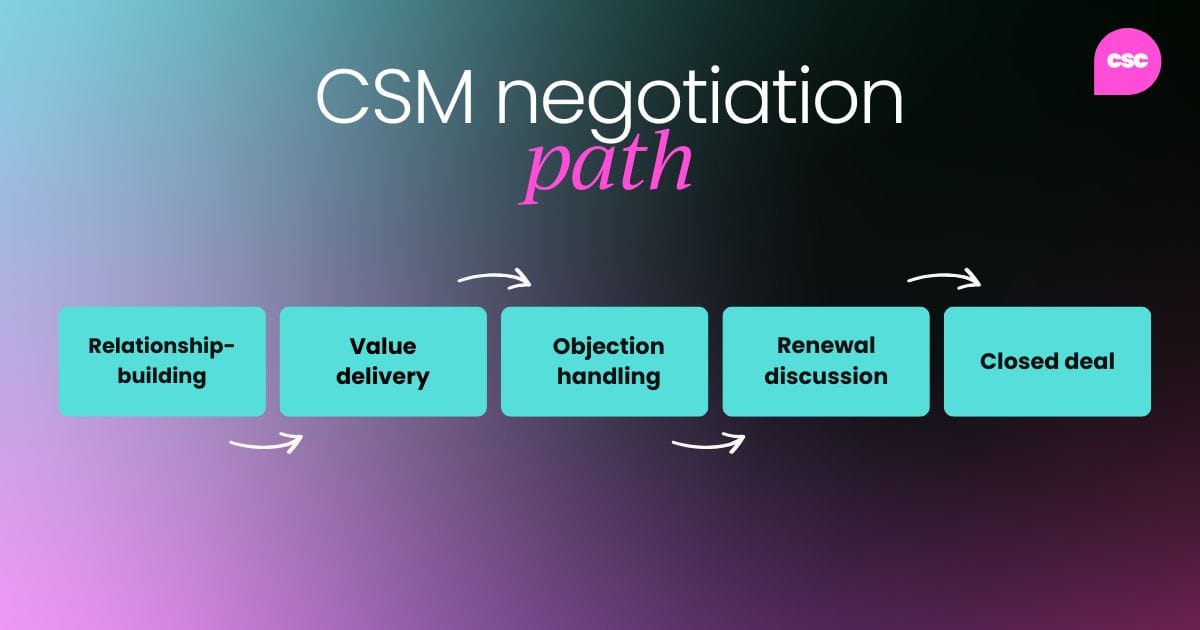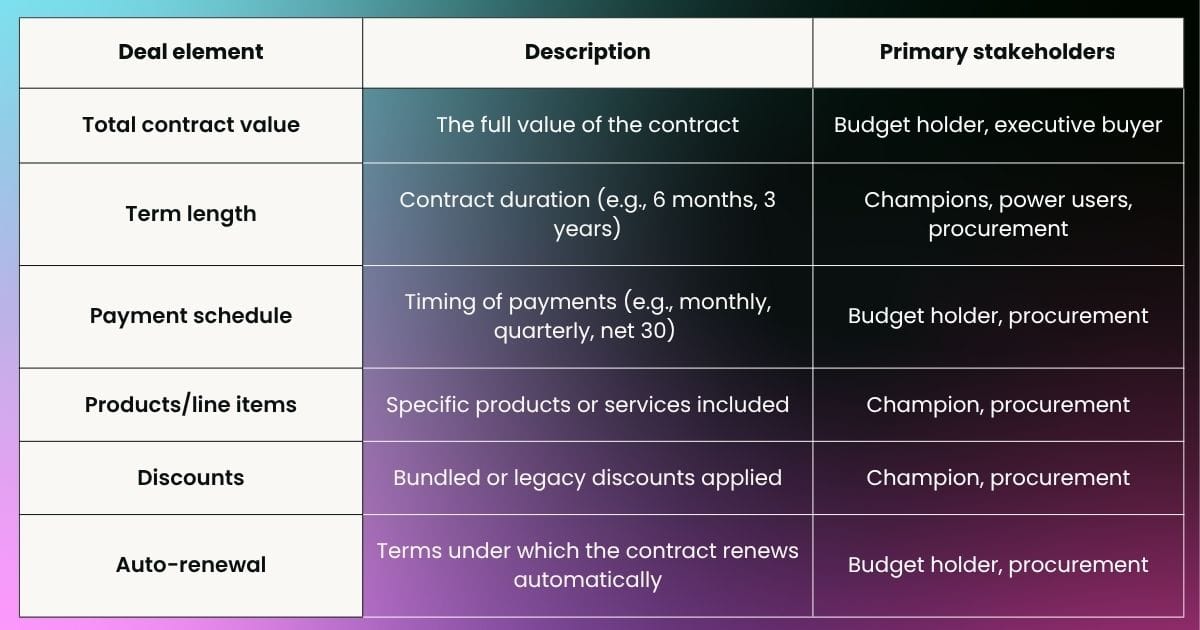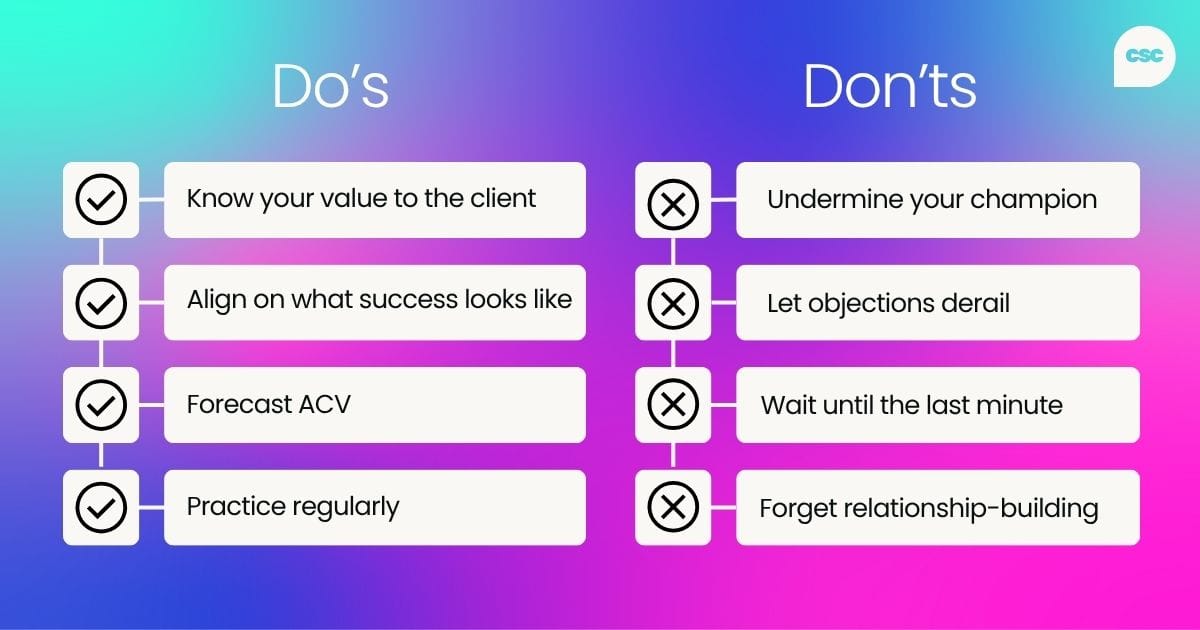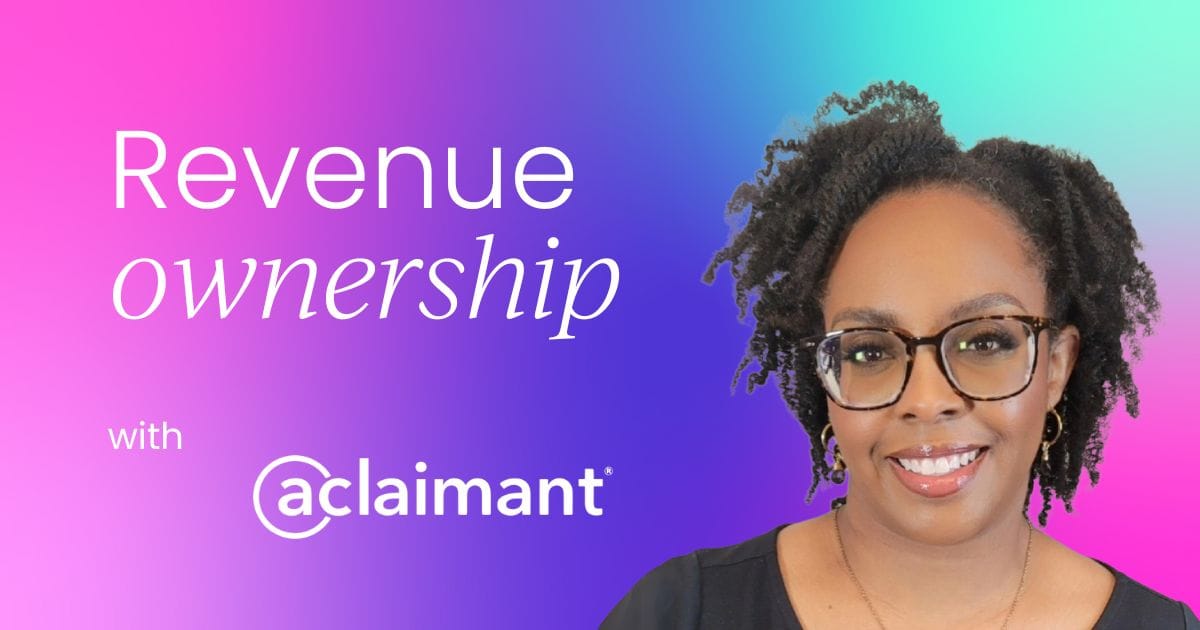You didn’t sign up to sell, but now… well, you own revenue. Like nearly half of customer success (CS) teams, you’re responsible for upsells, cross-sells and renewals. As CS shifts from a support function to a strategic growth driver, the definition of success is changing fast.
This evolution brings exciting opportunities, but also new pressures. CS leaders must now rethink how they approach metrics, performance, and, critically, negotiation.
What used to be a sales-led conversation is increasingly in CS’s hands.
The challenge? Many Customer Success Managers (CSM) chose this path because it originally prioritized relationships over revenue. But revenue responsibility isn’t going anywhere. And that means negotiation skills are no longer optional – they’re essential.
The evolution of the CSM role
Under the traditional RACI model (Responsible, Accountable, Consulted, Informed), CSMs were often "Accountable" for identifying opportunities but transitioned quickly into an "Informed" role once Sales took over.
Today, more and more CSMs are becoming directly "Responsible" for closing deals.
When I built my first customer success team, the company’s need for renewal ownership shaped our structure.
Those of us who had built trusted client relationships naturally stepped into negotiation roles and quickly learned the importance of managing objections (which always come up!), building trust, and creating a collaborative negotiation environment.
There was some initial concern that this was taking away opportunities from the Sales Executives to craft upsells and chip away at their quota. However, when this time-consuming activity was left to those already ingrained in accounts’ current states, our colleagues in our sales team were thrilled to have time to devote to larger deals and new logo acquisition.
By showing this early ROI for our sales departments helped bolster buy-in from the internal detractors.

Elements of negotiation
Mutual pathways to success
Renewals. Upsells. Increases to annual contract value (ACV). Too often, these deals follow rigid, single-path frameworks that limit a CSM’s ability to explore creative, value-based options.
But CSMs excel at consensus building and partnership. Through active listening and regular touchpoints like check-ins and executive business reviews, CSMs gain deep insight into what success looks like for each client.
Some clients prioritize predictability for budgeting purposes, while others value flexibility in payment terms. When we align your negotiations with your client's version of success, our CSMs can position themselves as a partner and not an adversary, solely looking out for their own interests.

In action
We had a technology client whose CSM learned that their budget cycle was changing. The client shared that annual payments created a ton of pain points for their team and presented an unnecessary hurdle when adding new functionality due to required budget increases.
While cash flow is critical for SME businesses like ours, our CSM recognized an opportunity: by accommodating the client's need for quarterly payments, we could secure a hefty upsell, strengthen the relationship, and transform the team leader from a passive participant into an active promoter of our partnership.
Our CSM successfully negotiated a multi-year contract that locked in the unique payment schedule, all the while securing a year-over-year increase that exceeded the client's typical budget parameters.
Celebrate wins
Great CSMs celebrate the wins the partnership has fostered along the way, so the natural next step is to review how to continue this partnership.
This approach builds trust, makes it easier to overcome objections from procurement or other internal detractors, allowing the CSM to offer multiple options tailored to different stakeholder priorities.
Negotiations aren’t a one-and-done moment but something the CSM should be thinking about actively throughout the year. By planting seeds and creating fertile moments of celebrations, the deal will be able to take root more naturally and feel like an extension of an ongoing business conversation.

Internal value framework
Negotiations aren’t only about ACV. Understanding the full range of deal components and how each one impacts value is critical. Here’s a breakdown of common elements, what they mean, and who typically cares most about them.

Taking the time to map out which elements matter most to your business and your customer stakeholders, from champions to power users to their managers, helps identify what makes a deal successful. Discussing these internally also ensures that CSMs are prepared to adapt mid-negotiation and address objections without sacrificing key value drivers.
Anchoring on key metrics that matter most to your business while also knowing which elements your business partners are going to need to anchor on provides a strong foundation for what pathways to success are most likely to take hold within a customer’s organization.
Procurement: Friend or foe?
A wise leader once said, “Good procurement works for the business, so if you’ve aligned with the business, procurement should just be a formality.”
In practice, procurement often brings insights that even your most engaged champions may lack. The best way to navigate procurement? Bring the business back into the conversation.
Very recently in the US, the tariffs disproportionately impacted some of our key clients in the fashion industry.
When our primary business contact informed us that their internal procurement team had started to review all contracts in a bid to cut costs, a CSM on my team immediately set up a call with their team leader and the business contact.

This allowed us to collaborate with our client to ensure that what was presented to procurement would satisfy our business needs, while supporting the client's most critical functions.
By presenting a deal that we knew the business would push for, our CSM was able to avoid full churn and maintain value through pretty uncertain times.
Sometimes your internal contacts may feel powerless against procurement. But involving them in conversations about roadblocks and how those issues might jeopardize the business’ success metrics can unlock influence they didn’t realize they had.
When CSMs can pivot to alternative deal paths, they demonstrate their flexibility and reinforce that the goal is a win-win agreement for everyone involved.
Do’s and don’ts of CSM negotiations
Do:
- Know your value to the client
- Align on what success looks like
- Forecast renewal and expansion of ACV to drive accountability
- Practice, practice, practice!
Don’t:
- Undermine your champion
- Let objections shut down conversations
- Leave negotiations until the final stages
- Forget your CS roots – relationship building is your superpower

Techniques for building negotiation skills
Knowing the language of negotiation
Being fluent in negotiation terminology empowers CSMs to respond confidently and quickly. It helps distinguish between true business-critical issues and surface-level pushback. A strong foundation in the language of CS metrics also enables more effective forecasting and deal construction.
Resources like this NRR vs CR primer and CS metrics calculator are great tools for training and standardization. They help teams evaluate deal health and establish benchmarks that give CSMs more autonomy and confidence in negotiations.
Instilling ownership by asking CSMs to forecast renewal ACV, new ACV, and churn fosters accountability and provides a strong foundation for performance coaching and compensation planning.
Agency not only leads to a better outcome for both parties at the negotiation table, but it is also shown time and time again to make employees feel valued and do a better job.
Role-playing and practice
Negotiation is a skill that improves with practice. Internal role-play exercises offer a safe space for CSMs to try out new strategies, experiment with different personas, and test boundaries, whether it’s pushing back on procurement or empathizing with internal business challenges.
Realistic role-playing scenarios with competing stakeholder interests are particularly effective. Afterward, encourage follow-ups where CSMs write mock emails or propose sample deal terms. These exercises help build muscle memory and develop confidence without risking real deals.
During annual kick-offs, we always bring our CSMs and Sales Directors together and use real-life situations that have come up during the past year to allow everyone to walk in the uncomfortable shoes of their peers.
There is, in some team members, a sense of competition and belief that making mistakes among peers is going to negatively impact their career, but this could not be further from the truth – those who are willing to be vulnerable often find themselves trying new talk-tracks out and elevating their game quickly.
Usually, by the third or fourth role-playing session, even the most competitive team member starts to see the value in stepping out of their comfort zone.

Safe practice opportunities
While it may be tempting for leaders to step in during tough negotiations, it’s vital to give individual contributors the space to lead.
One CSM on my team who had a strong background in different CSM roles, but had never overseen renewals, tended to bring me to every meeting that she thought might involve negotiations.
Finally, I was on some well-deserved PTO, and a client reached out needing to speak with her about the budget ASAP. She had to dive in and take the call, which quickly gave her the confidence to start pursuing these conversations independently.
CSMs often have the deepest rapport with customers, and that trust can be the key to successful outcomes. They’re the best judge of their clients’ temperaments and business savvy.
If, traditionally, a business finds that renewals take 90 days to close, ask the CSMs to initiate a conversation with a trusted business partner 120 days before the renewal. The extra buffer takes the pressure off and provides plenty of time for coaching.

Conclusion
Growth and revenue generation are becoming more important as margins and resources are getting crunched across industries.
As customer success takes on a more central role in revenue generation, negotiation becomes a core skill, but that doesn’t mean abandoning what makes CSMs special.
By applying their strengths in relationship-building, listening, and creative problem-solving, CSMs can lead negotiations that are thoughtful, flexible, and aligned to long-term success for both the customer and the business.
If you’re looking for practical resources, peer support, and the kind of knowledge that moves the needle – CSC membership was built for you.
With Pro+ membership plan, you’ll get:
- Just-in-time resources to solve problems fast – no starting from scratch
- A network of experienced CSMs to learn from, lean on, and grow with
- Strategic insights to lead with confidence and make smarter decisions
- Career development tools to help you stand out and move up
Whether you’re tackling a new project or planning your next career step, you’ll have everything you need – in one place.
Isn't it time to make decisions that drive meaningful results?



 Follow us on LinkedIn
Follow us on LinkedIn







